Preprint
Article
Evaluating Efficacy of Passive Occupational Exoskeleton for Enhancing Ergonomic Outcomes in Manufacturing
This is a preprint, it has not been peer-reviewed.
Submitted:
16 May 2024
Posted:
17 May 2024
You are already at the latest version
A peer-reviewed article of this preprint also exists.
Abstract
Manual material handling (MMH) significantly impacts worker health and productivity, often leading to musculoskeletal disorders (MSDs) primarily in the lower back. As a novel assistive technology, exoskeletons may serve as ergonomic tools to mitigate these work-related MSDs. It is essential to examine exoskeletons from the users’ perspectives before their widespread implementation in occupational settings. This study investigates the effectiveness of a passive back-support exoskeleton (BExo) in reducing perceived physical exertion and improving ergonomic safety in manufacturing context. Twenty-two college students were recruited to perform MMH tasks in a controlled lab environment, both with and without the BExo, followed by completing a survey questionnaire on various aspects of the BExo. Using ANOVA, the study analyzed biomechanical exertion across various body parts and tasks. The findings indicate that the BExo substantially alleviates discomfort in the low back, shoulders and knees, thereby, enhancing ergonomic posture and reducing fatigue. These results underscore the potential of passive exoskeletons to boost workers’ safety and efficiency, providing valuable insights for future ergonomic strategies in industrial setting.
Keywords:
-
1. Introduction
Manual material handling (MMH) is a critical component of manufacturing operations, and includes physical manipulation of objects through tasks such as lifting, carrying, and assembling [1]. These activities are prevalent across diverse manufacturing sectors, including logistics, warehouse management, and assembly lines. The importance of MMH in manufacturing ergonomics is profound, as it significantly influences worker health, safety, and productivity [2].
Occupational injuries and incidents impact employees’ lives and create significant financial challenges for workers, business, insurance companies and healthcare systems [3]. Inadequate material handling practices are a primary source of workplace injuries and musculoskeletal disorders (MSDs), particularly those affecting the lower back, which are pervasive in manufacturing environments. An approximate 27.8% of injuries in the workplace within the industrial sector are attributed to MSDs [4]. MSDs, especially back-related issues caused by excessive bio-mechanical strain, have substantial economic and social ramifications, affecting personal health and placing a strain on healthcare systems [5]. In addition, completing MMH occupational tasks in confined environments, such as most settings involving MMH, affects workers’ posture, time to finish tasks, and their overall performance [6].
Assessment and management of occupational risks is important in lowering the incidence of workplace injuries [7]. Addressing the inherent risks and challenges in MMH tasks is essential for ensuring worker safety and sustaining productivity. Traditional methods, such as reviewing workers’ compensation claims, have typically reflected a reactive stance to worker safety. However, a shift towards a proactive approach is utilizing predictive ergonomics to analyze worker-environment interactions. This could significantly mitigate the incidence of injuries. In this context, the adoption of assistive technologies like exoskeletons is pivotal. The advent of exoskeleton technology, particularly devices offering lower-back support, has introduced an era of engineered assistance for workers engaged in physically intensive tasks. These devices are designed to reduce injury risk and physical strain, therefore, improving workplace safety and efficiency.
Full adoption of passive exoskeletons as assistive technologies is hindered by a lack of clarity on users’ evaluation on their effects and risks [8,9]. Studies indicate that exoskeletons customized for individual needs may be more effective than generic models. However, thorough evaluations, weighing their advantages and disadvantages are still needed to guide developers, ergonomists, and users. Detailed analysis of how these exoskeletons can be used for performance improvement across various work tasks is also lacking. Thus, there is need for research to uncover the full potential and limitations of passive exoskeletons, specially through user-centric simulations that mirror typical manual labor tasks [10].
The goal of this study is to address this gap by providing a comprehensive analysis of users’ interactions with a passive back-supporting occupational exoskeleton. The study focuses on the advantages and difficulties encountered when users wear a back-support exoskeleton during tasks that involve manual handling of materials, set within simulations of actual industrial conditions. In addition, the research offers a statistical comparison of the participants’ reported physical exertion and the biomechanical effort they perceive while engaging in these tasks.
The structure of the rest of the paper is: Section 2 provides a literature review on similar assistive technologies and their benefits and challenges; section 3 details the materials and methods; section 4 presents results, and discussion of the findings. Section 5 on the summary of findings, discussion on study limitations, and future directions of research on assistive technologies concludes this paper.
2. Relevant Literature
In the pursuit of competitive advantage, manufacturing industries are increasingly adopting advanced technologies to create a dynamic work environment with high productivity [11]. One of these emerging technologies is the use of wearable assistive devices to boost workers’ productivity and health, as a crucial factor in maintaining industrial competitiveness. By enhancing occupational ergonomics, these emerging technologies contribute to meeting modern market demands and the well-being and efficiency of the workforce. In manufacturing sector, where MMH and other physically demanding tasks are commonplace, incorporation of wearable assistive technologies such as occupational exoskeletons can significantly alleviate the burden on workers. By offering biomechanical support and reducing fatigue, exoskeletons play a crucial role in promoting occupational health and ergonomics, making them a valuable asset in industries where manual labor is prevalent. Exoskeleton technology is rapidly becoming more prevalent, holding great promise for elevating the quality of workers’ lives [12]. Using exoskeletons for MMH tasks is particularly beneficial, as those tasks are usually associated with non-ergonomic postures, which lead to physical discomfort and injuries in long term [13].
The impact of this technology is especially notable in the development of occupational passive lower back-supporting exoskeleton (BExo), which are tailored to assist workers who are frequently involved in physically demanding activities. The advancement of technology has significantly increased the accessibility and practicality of exoskeletons in various workplace settings. This accessibility has encouraged more companies to explore exoskeleton as a tool for improving both worker safety and productivity [14]. Integrating assistive technology into manufacturing environments is vital for optimizing human performance, safety, and well-being. Aligning these technologies with human factors and ergonomics enables targeted design modifications, fostering user acceptance and trust [14,15,16]. Tailoring technology to ergonomic principles allows for specific design enhancements, creating a more user-friendly interface. By incorporating human factors and ergonomics, the design aligns with the natural capabilities and limitations of the human body, reducing the risk of injuries and fatigue.
An exoskeleton system represents a common form of interaction between humans and machines [17], and has two forms: powered and passive. Powered exoskeletons are mostly still restricted to laboratory research due to their higher costs and greater complexity. However, passive exoskeletons are growing in popularity for integration as assistive ergonomics tools into practical industry applications due to being more affordable and user-friendly [18,19].
Passive exoskeletons are innovative devices, engineered to reduce the risk of injury and alleviate the physical strain associated with such tasks, thereby enhancing workplace safety and productivity [20]. The passive lower-limb exoskeleton offers a viable substitute for its active counterpart by eliminating the need for batteries or any external power supply as well as relying on systems of springs and pulleys instead of motors to assist with movement. Its design, which often incorporates a belt or buckle for attachment, ensures it is both light and user-friendly, which makes it convenient to don and doff and enhances mobility and comfort for the user [21]. Besides reducing physical strain, the exoskeleton may also lighten cognitive load in tasks requiring prolonged posture, potentially improving balance and mental performance [22].
Research shows that exoskeletons are promising in enhancing manufacturing ergonomics by offering mechanical support that contributes to reducing strain on muscles and joints during MMH tasks [23,24]. Exoskeletons designed for back support could be beneficial in various contexts, given their ability to lower the activation level of back muscles. This reduction could decrease the likelihood of MSDs in tasks that involve frequent lifting or maintaining awkward and static positions [24,25].
Considering repetitive lifting tasks, a study on biomechanical analysis of BExo, using simulation of lifting, showed that the use of exoskeleton plays a significant role in reducing lumbar spine stress and lowering metabolic energy expenditure during symmetric lifting activities, highlighting its potential utility in diverse work environments where repetitive lifting is a requirement [23]. Another study highlighted that passive exoskeleton support users by supplying some of the torque needed for physical tasks, such as lifting or holding a bent posture. As a result, the devices have the potential to lessen the effort demanded from the spinal muscles, reduce spinal strain and enhance task performance [8]. A study by Lazzaroni, et. al., [5], showed a lessened compressive load on the spinal disc as a result of wearing a BExo, showing its potential in reducing the likelihood of incurring back-related MSDs. Considering the walking task, research findings indicate that utilizing an exoskeleton can lead to a reduction in the energy expenditure associated with walking. This suggests that exoskeletons have the potential to enhance walking efficiency by lowering the metabolic demands on the body [26].
Despite the growing body of research on passive exoskeletons in occupational settings, a major obstacle to their broadened utilization in industrial settings is the limited or incomplete understanding of their impact and potential risks. Previous research has shown that customizable exoskeletons, tailored to individual user needs, are expected to outperform standardized, one-size-fits-all models in terms of effectiveness [27]. Additionally, there is a deficiency in comprehensive evaluations that discuss the pros and cons of these devices which is crucial for informing developers, ergonomics specialists, consumers, and workers [8,9]. Moreover, there is an absence of detailed studies on the performance of passive exoskeletons in varying work tasks [21]. Therefore, it is essential to conduct targeted research to explore both the challenges and strengths of these exoskeletons, particularly from the perspective of end-users engaged in simulated tasks that replicate common job assignments such as manual material handling.
3. Methods
This section elaborates on the methodology and procedures used in the study. We designed a set of MMH tasks to be completed by the participants across two sessions: one with the use of an exoskeleton, and one without. Each participant was confirmed to be in good health, without any physical discomfort, medical conditions or musculoskeletal disorders. All study procedures in this research adhered to the Declaration of Helsinki and received approval from the Institutional Review Board and the Office of Research Compliance and Integrity of Santa Clara University (No: 23-11-2076). In addition, prior to their participation in the study, informed consent was collected from all individuals.
3.1. Participants
This study involved 22 college students who volunteered as participants and explored the interaction between users and a passive back-supporting exoskeleton during manual material handling tasks. The participant group consisted of 12 females and 10 males, accounting for 54.55% and 45.45% of the sample, respectively. The average age of participants is approximately 20.5 years, with a standard deviation of 4.48 years and a median age of 19 years. Participants’ average weight was around 146.26 pounds, with a standard deviation of 25.25 pounds and a median of 144.40 pounds. No participant had a current or historical musculoskeletal disorder.
3.2. Experiment, Apparatus and Tasks
We utilized the Ottobock BackX (Figure 1), a passive back-support exoskeleton designed for industrial applications, to perform simulated manual material handling (MMH) tasks. According to the device guidelines, this BExo is designed to alleviate gravity-induced forces on the lower back, and reduces exertion during tasks involving stooping, lifting, and reaching by providing supportive force to user’s chest and -thighs. We followed the guidelines to adjust the exoskeleton based on each participant’s physical characteristics, and all procedures of donning and doffing the exoskeleton were strictly adhered to during the experiments. Prior to the start of the experiment, participants received an orientation session to get acquainted with the study protocol and equipment. They were provided with a consent form which detailed the study’s scope and allowed them ample time to read and consent to their participation. All participants voluntarily agreed to participate and completed the consent forms before beginning the tasks. They were informed that they could withdraw from the study at any time without any consequences. However, all participants completed the tasks as planned. Upon concluding the experimental tasks, participants were asked to fill out a survey to gather their feedback on the experience.
The study involved participants performing these tasks both with and without the exoskeleton support. The experiment had several distinct activities (Table 1). Breaks of an average of 3-5 minutes were provided throughout the session to prevent fatigue and ensure the participants’ well-being. Initially, each participant performed a sequence that included walking for two minutes, then carrying and lifting a 7 kg (15.6-pound) box. These tasks were completed without the aid of the exoskeleton. The walking task included participants walking in the lab, 8ft distance, back and forth at their preferred walking speed. The carrying task involved moving the box between two points that were 2.6 meters (8 ft) apart within the laboratory setting. Each task of carrying and lifting the box was repeated in two sets of three repetitions. The height at which the box was to be placed during the lifting tasks was fixed at 90 centimeters (2 ft). The scenarios and task execution are shown below in Figure 2 (photos published with participant’s consent).
3.3. Survey Components and Analysis
During the experimental trials, participants evaluated their perceived discomfort using the Borg CR10 scale, where a score of 0 signifies no discomfort and 10 represents the highest level of discomfort [28] Participants rated each body part, including the neck, shoulders, upper body, chest, wrist, lower body, knees, ankle, feet, and elbow. The Borg scale is a reliable method for assessing user perception in experiments involving various tasks. This subjective evaluation provides direct insights into individual interactions with the exoskeleton and the intensity of physical effort. Lower ratings on the Borg scale after using the exoskeleton indicate its effectiveness in reducing strain and workload.
In addition to the Borg scale, participants completed a detailed survey assessing several dimensions of the exoskeleton’s usability and impact. The survey included sections on ease of use, practical utility, user attitudes, trust, and overall experience. Each aspect was rated on a scale from 0 to 10. The purpose of a detailed survey was to provide a comprehensive assessment of the exoskeleton from multiple perspectives, ensuring a thorough understanding of its usability, impact, and areas for improvement. The detailed feedback from participants offers valuable insights for further development and optimization of exoskeleton technologies in occupational settings.
Ease of Use: Participants rated cognitive effort, movement freedom, physical effort, and overall ease of use. This comprehensive evaluation covers mental demand, autonomy of movement, physical exertion, and user-friendliness.
Usability: Participants assessed posture improvement, fatigue level, perceived inefficiency, movement constraint, and overall helpfulness. These factors provide a holistic view of the exoskeleton’s impact on physical alignment, user fatigue, and task efficiency.
Attitudes and Trust: Participants rated the exoskeleton’s trustworthiness, ergonomic impact, general sentiment, comfort, and perceived innovation. Understanding these attitudes helps gauge user confidence and acceptance of the technology.
Additional Feedback: Participants were also asked to provide their ratings on usage likelihood, perceived power augmentation, training requirements, and impact on autonomy. These ratings offer insights into the practical considerations and user expectations of the exoskeleton.
The survey results were analyzed using descriptive statistical methods to quantify and interpret the intensity of perceived discomfort and the overall effectiveness of the exoskeleton in completing manual material handling tasks. The analysis aimed to provide critical insights for ergonomic improvements and enhance occupational health and safety.
4. Results and Discussion
This section presents the study’s results and explores the potential applications of the insights gained from using the BExo as an ergonomic tool for improving occupational safety and health in heavy tasks, such as manual material handling. We conducted statistical analyses, including ANOVA and Tukey’s HSD test for mean comparison, to evaluate the total perceived physical exertion experienced by participants during various tasks performed with and without the back-supporting exoskeleton. Additionally, we analyzed responses from the Borg scale questionnaire, reporting the average score out of 10 per attribute to provide further insights into user interactions with this assistive device.
4.1. Overall Impact of BExo
The one-way ANOVA for exoskeleton support showed a significant reduction in overall perceived physical exertion when the back-supporting exoskeleton was used, with a F-ratio of 8.07 (p-value of 0.0062, statistically significant at α=0.05). This indicates that the differences in PPE with and without the exoskeleton are unlikely to be due to chance. The mean difference in PPE scores between exoskeleton and no exoskeleton is 7.25, with a 95% confidence interval of 2.09 to 12.41, confirming the significant difference. Therefore, there is a significant reduction in PPE when tasks are performed with the exoskeleton, demonstrating its effectiveness in alleviating physical strain across various tasks. This highlights the potential of exoskeletons as an indispensable ergonomic tool in high-exertion settings such as manufacturing. Average PPE across all experiments is shown in Figure 3.
4.2. BExo Impact on Body Parts
The comparison for the average sum of PPE with and without the use of an exoskeleton across different body parts is shown in Figure 4. The BExo significantly reduces the perceived physical exertion for several body parts. For the lower back, the reduction is substantial, with a decrease of 22.67 points, indicating major alleviation of exertion. The knee shows a notable reduction of 9.33 points, and the shoulder sees a significant drop of 10 points. The upper back experiences a reduction of 9 points, while the ankle and wrist show decreases of 6.66 and 5.33 points, respectively. The feet and elbow also benefit from the exoskeleton, with reductions of 4 and 3.67 points, respectively.
In contrast, the chest experiences a slight increase in PPE with the exoskeleton, with a rise of 3 points, suggesting the exoskeleton might add some load to this area. The neck shows a minimal reduction in PPE, with a decrease of only 1.34 points, indicating that the exoskeleton’s impact on the neck is not as pronounced. Overall, the exoskeleton appears to be effective in reducing physical exertion in most body parts, particularly in the lower back, knee, and shoulder, while having less significant or slightly adverse effects on others like the chest and neck.
4.3. BExo Impact on PPE in Different Tasks
The analysis of perceived physical exertion across different tasks, such as walking, lifting, and carrying a box, reveals significant variations, as shown by the ANOVA results with an F-ratio of 9.44 and a p-value of 0.0003 (Table 3). This indicates that the type of task substantially affects the level of physical exertion experienced by individuals, emphasizing the importance of task characteristics in evaluating the effectiveness of exoskeleton usage. The significant differences across tasks suggest that exoskeletons may provide varying degrees of support depending on the specific activities performed.
The Tukey’s HSD test was performed to compare PPE scores across different tasks (walking, carrying a box, and lifting a box) with and without exoskeleton support. For the walking task, the mean difference in PPE scores between exoskeleton and no exoskeleton conditions was 3.8 (p-value of 0.0553), indicating no statistically significant difference (95% CI: -0.07 to 7.67). For the lifting task, the test showed a significant mean difference of 8.15 in PPE scores based on using exo, with a p-value of 0.0420 (95% CI: 0.31 to 15.99), confirming that the exoskeleton significantly reduces physical exertion for lifting tasks. For the carrying task, the mean difference in PPE scores was 6.55, with a p-value of 0.0814, suggesting no statistically significant difference (95% CI: -0.78 to 13.88).
These results highlight the effectiveness of the exoskeleton in significantly reducing physical exertion during lifting tasks, while the impact on walking and carrying tasks is less pronounced. These results are visually confirmed in Figure 5 and provide compelling argument for the targeted use of exoskeletons in particularly strenuous tasks. This could potentially guide ergonomic interventions more effectively in workplace settings.
4.3.1. Lifting Box
As shown in Figure 6, the most impacted body parts benefiting from the use of an exoskeleton during the task of lifting a box are the lower back, knee, and shoulder. The lower back, in particular, shows a significant reduction in perceived physical exertion (PPE) when using the exoskeleton, with PPE scores dropping from around 60 to 20. The knee also exhibits a notable decrease, with PPE scores decreasing from approximately 35 to 15. Similarly, the shoulder benefits substantially from exoskeleton support, with PPE scores reduced from around 30 to 15. These findings highlight the effectiveness of exoskeletons in alleviating physical strain on the lower back, knees, and shoulders during lifting tasks, potentially reducing the risk of occupational injuries and enhancing ergonomic support in high-exertion activities.
4.3.2. Carrying Box
Looking at the effect of BExo on PPE in the task where participants carried the box (Figure 7), the lower back exhibits the highest PPE score without the exoskeleton, at approximately 55, which is substantially reduced to around 25 with the exoskeleton, demonstrating its effectiveness in alleviating lower back strain. Similarly, the shoulders show a high PPE score of about 45 without the exoskeleton, which decreases to approximately 20 with its use, while the neck shows a reduction from around 35 to 15, highlighting the exoskeleton’s benefits for these body parts. The upper back has a PPE score of about 30 without the exoskeleton, reduced to around 10 with it, and the arms show a decrease from about 25 to 10. This highlights that the body parts experiencing the highest exertion without exoskeleton support benefit the most from its use. This evidence validates the exoskeleton’s role in significantly reducing physical exertion, particularly for the lower back, shoulders, and neck, during carrying tasks, emphasizing its potential as a valuable ergonomic tool in high-exertion activities.
4.3.3. Walking
The average perceived physical exertion per body part for the task of walking, comparing conditions with and without the exoskeleton is given in Figure 8. The knees exhibit the highest PPE score without the exoskeleton, at approximately 16, which is reduced to around 14 with the exoskeleton, demonstrating its effectiveness in alleviating knee strain. The feet show a PPE score of about 15 without the exoskeleton, which decreases to approximately 10 with its use. Similarly, the ankles have a PPE score of around 14 without the exoskeleton, which decreases to 8 with its use.
The lower back shows a PPE score of about 13 without the exoskeleton, reduced to around 6 with it. The elbows have a reduction in PPE from approximately 12 to 6. Other body parts, such as the neck, shoulders, upper back, and chest, also experience reductions in PPE, though to a lesser extent. The neck shows a decrease from around 10 to 5, the shoulders from 9 to 4, the upper back from 8 to 5, and the chest from 7 to 4. These reductions underscore that the body parts experiencing the highest exertion without exoskeleton support benefit the most from its use. This evidence validates the exoskeleton’s role in significantly reducing physical exertion, particularly for the knees, feet, and lower back, during walking tasks, emphasizing its potential as a valuable ergonomic tool in high-exertion activities.
4.4. Interaction Effect Analysis Using ANOVA
An ANOVA model was developed to investigate the effects of task, support, and body part, as well as their two-way interactions, on PPE. This analysis (Table 4) confirms the previous results regarding the significant effects across all main factors and adds new insights into their interactions. The interaction between task and support demonstrates a F Ratio of 3.95, suggesting that the impact of support varies depending on the task performed. The task and body part interaction, with an F Ratio of 4.22, indicates that the exertion felt differs by body part depending on the specific task, emphasizing the role of task specificity on physical exertion. Additionally, the interaction between support and body part, with an F Ratio of 4.21, implies that the effectiveness of exoskeleton support varies across different body parts.
These results collectively underscore the complex dynamics between task types, support mechanisms, and body part engagement, which are crucial for designing ergonomic interventions and optimizing task allocation in work settings to minimize physical strain and enhance performance efficiency.
4.4.1. Parameter Estimate from Two-Way ANOVA Model
The detailed parameter estimates for each factor, their levels, and interactions, resulting from the two-way ANOVA model is given in Appendix A. The results with statistical significance are summarized in Table 5. The task-related effects show that both Task C (carrying) and Task L (lifting) increase exertion significantly compared to the baseline of walking, with lifting being slightly more demanding than carrying. The support from the exoskeleton (Support [Ex]) significantly reduces perceived exertion by 3.8500 units, indicating its effectiveness in alleviating physical strain. Regarding body parts, lower back and knee report higher exertion levels than the baseline body part, with lower back showing the most significant increase. Conversely, exertion levels for the ankle, elbow, feet, and neck are significantly lower, which might reflect less strain or different kinds of movements involving these parts during the tasks. The interaction effects also highlight interesting dynamics between supports and body parts. Specifically, the exoskeleton provides additional benefits when interacting with the chest area, reducing exertion further by 5.3500 units. However, its interaction with the lower back is even more noteworthy, reducing exertion by 7.4833 units, indicating a targeted effectiveness at this common part of strain. Task-specific interactions further reveal that carrying a box increases exertion in both the lower and upper back significantly. Similarly, lifting the box also elevates exertion in the lower back. These findings underscore the complex interplay between task types, ergonomic supports, and anatomical impacts, suggesting that exoskeleton design and task adjustments should be considerate of specific body part vulnerabilities and task demands to optimize worker health and productivity. Full results with all variables and interactions are included in Appendix A, Table 6.
4.5. Analysis of Survey
The scoring of each attribute regarding users’ interaction with the BExo is shown in Figure 9. The survey results were analyzed to provide a comprehensive assessment of the exoskeleton’s impact on user experience, usability, and overall effectiveness. Each survey component was evaluated based on the feedback from participants, with scores ranging from 0 to 10. These survey results provide valuable insights into the potential of exoskeletons to enhance workplace safety and reduce the risk of injuries. High scores in safety, trust, and ergonomic assistance underscore their benefits. However, moderate scores in empowerment and willingness to reuse suggest room for improving design and functionality. Addressing feelings of constraint and intimidation can further enhance user experience and acceptance.
Certain attributes with mean and median values greater than 5, including helpfulness, ease of use, feel safe wearing exo, trust in exo, and posture improvement show positive user perceptions. These metrics recorded mean values of 5.41, 6.32, 6.91, 6.59, and 5.55, and medians of 6.00, 7.00, 7.00, 7.00, and 5.50 respectively. The high scores in these categories indicate that users generally find the exoskeleton beneficial in enhancing posture, straightforward to operate, and instilling a sense of safety and reliability. Such feedback is crucial, highlighting the exoskeleton’s utility in improving worker safety and efficiency, while also suggesting a robust trust and comfort level among users.
Attributes with mean and median values less than 5, such as perceived tiredness, perceived time wasted, perceived exo as a constraint, cognitive effort, level of freeness, and perceived physical effort, which scored lower by users indicate areas needing enhancement. The respective mean values for these metrics are 2.64, 1.86, 3.09, 2.41, 5.09, and 3.27, with medians of 2.50, 2.00, 3.00, 2.00, 4.50, and 3.00. These findings suggest that the exoskeleton does not significantly increase tiredness or cognitive burden which are indicative of its ergonomic design as a beneficial tool. However, the moderate scores for perceived constraint and physical effort point to some discomfort and restricted movement. Additionally, the middling score for freeness suggests that users experience a degree of movement limitation, which could affect task performance and overall satisfaction.
For detailed description of categories of attributes as in survey components, Figure 10 depicts the sorted mean values.
4.5.1. Ease of Use
Participants rated cognitive effort, movement freedom, physical effort, and overall ease of use. The cognitive effort required to use the exoskeleton was rated at 2.42 out of 10, suggesting that the mental demand of operating the device is relatively low. Movement freedom, or freeness, scored 5.09 out of 10, indicating a moderate level of autonomy in movement while using the exoskeleton. Physical effort required to operate the exoskeleton was rated 3.27 out of 10, reflecting that the physical exertion needed is manageable but could be improved. Overall, the exoskeleton’s ease of use was rated 6.32 out of 10, suggesting that while the device is generally user-friendly, there are opportunities to further reduce the cognitive and physical effort required to use it effectively.
4.5.2. Usability
Usability was assessed through several dimensions, including posture improvement, fatigue level, perceived inefficiency, movement constraint, and overall helpfulness. The exoskeleton received a posture improvement rating of 5.55 out of 10, highlighting its effectiveness in enhancing physical alignment. Participants reported a fatigue level (tiredness) of 2.64 out of 10, indicating that the exoskeleton helps to significantly reduce fatigue during use. Perceived inefficiency, or time wasted, was rated very low at 1.86 out of 10, suggesting that the exoskeleton does not significantly hinder productivity. However, movement constraint received a score of 3.09 out of 10, indicating that some users felt restricted in their movements while using the device. Overall, the helpfulness of the exoskeleton was rated 5.41 out of 10, reflecting a positive impact on task efficiency but also highlighting areas for improvement in reducing movement constraints.
4.5.3. Attitude and Trust
Participants provided ratings on various aspects of their attitudes towards the exoskeleton, including trustworthiness, ergonomic impact, general sentiment, comfort, and perceived innovation. Trustworthiness received a high rating of 6.59 out of 10, showing that users felt confident in the device’s reliability and functionality. The ergonomic impact, measured as ergonomic assistance, was rated 6.0 out of 10, indicating that the exoskeleton provides significant support in reducing physical strain. General sentiment, or how much participants liked the exoskeleton, was rated 6.23 out of 10, reflecting a generally positive attitude towards the device. Comfort received a score of 5.86 out of 10, suggesting that while the exoskeleton is relatively comfortable, there is room for enhancement. Perceived innovation was rated 5.09 out of 10, indicating moderate recognition of the exoskeleton’s technological advancement.
4.5.4. Additional Feedback
Participants were also asked to provide their ratings on usage likelihood, perceived power augmentation, training requirements, and impact on autonomy. Usage likelihood, or the intention to reuse the exoskeleton, was rated 4.44 out of 10, suggesting that while the overall experience was positive, there is room to increase the willingness to reuse the device. Perceived power augmentation, or empowerment, received a rating of 4.82 out of 10, indicating that the exoskeleton moderately enhances the user’s sense of strength and capability. Training requirements were rated very low at 2.41 out of 10, reflecting that minimal training is needed to use the exoskeleton effectively. Impact on autonomy, measured as loss of autonomy, was also rated low at 2.45 out of 10, suggesting that the exoskeleton does not significantly hinder the user’s sense of control and independence.
Overall, the feedback suggests that while the exoskeleton has a positive impact on reducing physical exertion and supporting safer lifting practices, further refinement in its design could improve flexibility, comfort, and broader utility in various manual handling tasks. These insights are crucial for the ongoing development and optimization of exoskeletal devices in occupational settings. The details for each section are in the following.
5. Conclusions
This study conclusively demonstrates the efficacy of a passive back-supporting exoskeleton (BExo) in reducing physical exertion and enhancing ergonomic posture during manual material handling tasks in manufacturing settings. Our findings show that the exoskeleton significantly decreases discomfort in critical areas such as the back, shoulders, and knees, which are often prone to injury in industrial environments. By enhancing ergonomic postures, the exoskeleton alleviates immediate physical strain and contributes to the long-term prevention of musculoskeletal disorders, a leading cause of workplace injuries. The ANOVA results revealed that the exoskeleton significantly reduces perceived physical exertion across various tasks and body parts. Notably, significant reductions were observed in the lower back, shoulders, and knees, underscoring the device’s effectiveness in mitigating physical strain. These findings are further corroborated by the survey results, which indicate that users experienced improved posture and reduced fatigue. Despite these positive outcomes, the survey also highlighted areas for improvement, particularly in reducing feelings of constraint and improving overall comfort.
Participants expressed generally positive attitudes towards the exoskeleton, rating its trustworthiness, ergonomic impact, and overall helpfulness highly. However, moderate scores in perceived empowerment and willingness to reuse suggest that further refinement is needed to enhance user experience and acceptance. Addressing these issues, particularly the feelings of constraint and the physical effort required to use the device, could significantly improve its usability and effectiveness.
The study was limited by its sample size and demographic, which primarily involved young, healthy college students. This sample may not fully represent the broader workforce demographic in manufacturing settings. Additionally, the laboratory environment does not entirely mimic the complexities and variations of real-world manufacturing scenarios, which may affect the generalizability of the results. These limitations suggest the need for further research involving more diverse populations and real-world settings to validate and expand upon these findings.
Future research should focus on larger, more diverse populations and include field studies to evaluate the practical applications of exoskeletons in actual work environments. Studies should also explore the long-term effects of exoskeleton usage on worker health and productivity, including potential negative outcomes such as dependency or over-reliance on the technology. To address the variations in task performance, further development could involve adjustable and customizable exoskeleton designs tailored to specific tasks or user needs. Additionally, addressing the gender-specific differences observed could involve ergonomic adjustments and personalized fitting sessions to ensure the technology is equally beneficial and accessible to all users.
Given these insights, the deployment of passive exoskeletons in manufacturing could lead to considerable improvements in worker safety, comfort, and productivity. However, to fully realize these benefits, ongoing refinement of the design, personalized training programs, and adaptation to user feedback are essential. This study lays a strong foundation for future research and development in this field, aiming to tailor ergonomic solutions that meet diverse industrial needs while promoting a safer and more efficient workforce.
Author Contributions
Conceptualization, F.D.K.; methodology, F.D.K.; software, F.D.K and A.M.; validation, F.D.K and A.M.; formal analysis, F.D.K; investigation, F.D.K; resources, F.D.K.; data curation, H.V and A.N.; writing—original draft preparation, F.D.K., A.M.; writing—review and editing, all authors; visualization, F.D.K.; supervision, F.D.K.; project administration, F.D.K; funding acquisition, F.D.K. All authors have read and agreed to the published version of the manuscript.
Funding
This research received no external funding.
Data Availability Statement
The data presented in this study are only partially available on request from the corresponding author due to the privacy protocols as in the IRB approval documents.
Acknowledgments
The authors would like to thank all participants involved in the study.
Conflicts of Interest
The authors declare no conflicts of interest.
Appendix A
Table 6.
Results from Tow-Way ANOVA model.
| Term | Estimate | Std Error | t-ratio | P-value |
| Intercept | 15.0167 | 0.5163 | 29.0800 | <.0001 |
| Task[C] | 3.6333 | 0.7302 | 4.9800 | <.0001 |
| Task[L] | 4.1333 | 0.7302 | 5.6600 | <.0001 |
| Support[Ex] | -3.8500 | 0.5163 | -7.4600 | <.0001 |
| BodyPart[ankle] | -5.0167 | 1.5490 | -3.2400 | 0.0046 |
| BodyPart[chest] | -1.8500 | 1.5490 | -1.1900 | 0.2479 |
| BodyPart[elbow] | -6.1833 | 1.5490 | -3.9900 | 0.0009 |
| BodyPart[feet] | -4.6833 | 1.5490 | -3.0200 | 0.0073 |
| BodyPart[knee] | 5.6500 | 1.5490 | 3.6500 | 0.0018 |
| BodyPart[lower back] | 14.6500 | 1.5490 | 9.4600 | <.0001 |
| BodyPart[neck] | -4.6833 | 1.5490 | -3.0200 | 0.0073 |
| BodyPart[shoulder] | 0.8167 | 1.5490 | 0.5300 | 0.6045 |
| BodyPart[upper back] | 4.6500 | 1.5490 | 3.0000 | 0.0077 |
| Task[C]*Support[Ex] | -0.6000 | 0.7302 | -0.8200 | 0.4220 |
| Task[L]*Support[Ex] | -1.4000 | 0.7302 | -1.9200 | 0.0712 |
| Support[Ex]*BodyPart[ankle] | 0.5167 | 1.5490 | 0.3300 | 0.7426 |
| Support[Ex]*BodyPart[chest] | 5.3500 | 1.5490 | 3.4500 | 0.0028 |
| Support[Ex]*BodyPart[elbow] | 2.0167 | 1.5490 | 1.3000 | 0.2094 |
| Support[Ex]*BodyPart[feet] | 1.8500 | 1.5490 | 1.1900 | 0.2479 |
| Support[Ex]*BodyPart[knee] | -0.8167 | 1.5490 | -0.5300 | 0.6045 |
| Support[Ex]*BodyPart[lower back] | -7.4833 | 1.5490 | -4.8300 | 0.0001 |
| Support[Ex]*BodyPart[neck] | 1.8500 | 1.5490 | 1.1900 | 0.2479 |
| Support[Ex]*BodyPart[shoulder] | -0.9833 | 1.5490 | -0.6300 | 0.5335 |
| Support[Ex]*BodyPart[upper back] | -1.8167 | 1.5490 | -1.1700 | 0.2562 |
| Task[C]*BodyPart[ankle] | -3.1333 | 2.1906 | -1.4300 | 0.1698 |
| Task[C]*BodyPart[chest] | -2.3000 | 2.1906 | -1.0500 | 0.3076 |
| Task[C]*BodyPart[elbow] | -2.9667 | 2.1906 | -1.3500 | 0.1924 |
| Task[C]*BodyPart[feet] | -3.9667 | 2.1906 | -1.8100 | 0.0869 |
| Task[C]*BodyPart[knee] | -2.8000 | 2.1906 | -1.2800 | 0.2174 |
| Task[C]*BodyPart[lower back] | 6.7000 | 2.1906 | 3.0600 | 0.0068 |
| Task[C]*BodyPart[neck] | -0.4667 | 2.1906 | -0.2100 | 0.8337 |
| Task[C]*BodyPart[shoulder] | 3.5333 | 2.1906 | 1.6100 | 0.1242 |
| Task[C]*BodyPart[upper back] | 6.7000 | 2.1906 | 3.0600 | 0.0068 |
| Task[L]*BodyPart[ankle] | -3.6333 | 2.1906 | -1.6600 | 0.1145 |
| Task[L]*BodyPart[chest] | 2.2000 | 2.1906 | 1.0000 | 0.3286 |
| Task[L]*BodyPart[elbow] | -1.4667 | 2.1906 | -0.6700 | 0.5117 |
| Task[L]*BodyPart[feet] | -3.9667 | 2.1906 | -1.8100 | 0.0869 |
| Task[L]*BodyPart[knee] | 0.2000 | 2.1906 | 0.0900 | 0.9283 |
| Task[L]*BodyPart[lower back] | 6.2000 | 2.1906 | 2.8300 | 0.0111 |
| Task[L]*BodyPart[neck] | -1.9667 | 2.1906 | -0.9000 | 0.3812 |
| Task[L]*BodyPart[shoulder] | 1.0333 | 2.1906 | 0.4700 | 0.6428 |
| Task[L]*BodyPart[upper back] | 0.2000 | 2.1906 | 0.0900 | 0.9283 |
References
- S. T. Yang, M. H. S. T. Yang, M. H. Park, and B. Y. Jeong, “Types of manual materials handling (MMH) and occupational incidents and musculoskeletal disorders (MSDs) in motor vehicle parts manufacturing (MVPM) industry,” Int J Ind Ergon, vol. 77, 20. 20 May. [CrossRef]
- M. R. Suryoputro, K. M. R. Suryoputro, K. Wildani, and A. D. Sari, “Analysis of manual material handling activity to increase work productivity (Case study: Manufacturing company),” in MATEC Web of Conferences, EDP Sciences, Feb. 2018. [CrossRef]
- F. Davoudi Kakhki, S. A. F. Davoudi Kakhki, S. A. Freeman, and G. A. Mosher, “Evaluating machine learning performance in predicting injury severity in agribusiness industries,” Saf Sci, vol. 117, pp. 257–262, Aug. 2019. [CrossRef]
- F. A. Reyes, D. F. A. Reyes, D. Shuo, and H. Yu, “Shoulder-Support Exoskeletons for Overhead Work: Current State, Challenges and Future Directions,” IEEE Trans Med Robot Bionics, vol. 5, no. 3, pp. 516–527, Aug. 2023. [CrossRef]
- M. Lazzaroni et al., “Evaluation of an acceleration-based assistive strategy to control a back-support exoskeleton for manual material handling,” Wearable Technologies, vol. 1, Jan. 2020. [CrossRef]
- P. Bhat et al., “Assessing limited visibility feedback for overhead manufacturing assembly tasks,” Appl Ergon, vol. 97, Nov. 2021. [CrossRef]
- B. Bepary and G. Kabir, “Occupational Risk Assessment of Wind Turbines in Bangladesh,” Applied System Innovation, vol. 5, no. 2, Apr. 2022. [CrossRef]
- S. Toxiri et al., “Back-support exoskeletons for occupational use: An overview of technological advances and trends,” IISE Trans Occup Ergon Hum Factors, vol. 7, no. 3–4, pp. 237–249, 2019. [CrossRef]
- M. Lazzaroni et al., “Back-support exoskeleton control strategy for pulling activities: Design and preliminary evaluation,” Designs (Basel), vol. 5, no. 3, Sep. 2021. [CrossRef]
- M. Savković, M. M. Savković, M. Dašić, M. Đapan, A. Vukićević, I. Mačužić, and M. Stefanović, “IMPROVING WORKPLACE SAFETY USING ADVANCED INDUSTRY 4.0 TECHNOLOGIES.
- L. S. Goecks, A. F. L. S. Goecks, A. F. Habekost, A. M. Coruzzolo, and M. A. Sellitto, “Industry 4.0 and Smart Systems in Manufacturing: Guidelines for the Implementation of a Smart Statistical Process Control,” Applied System Innovation, vol. 7, no. 2, p. 24, Mar. 2024. [CrossRef]
- M. Pesenti, G. M. Pesenti, G. Invernizzi, J. Mazzella, M. Bocciolone, A. Pedrocchi, and M. Gandolla, “IMU-based human activity recognition and payload classification for low-back exoskeletons,” Sci Rep, vol. 13, no. 1, Dec. 2023. [CrossRef]
- R. M. van Sluijs, M. R. M. van Sluijs, M. Wehrli, A. Brunner, and O. Lambercy, “Evaluation of the physiological benefits of a passive back-support exoskeleton during lifting and working in forward leaning postures,” J Biomech, vol. 149, Mar. 2023. [CrossRef]
- L. Botti and R. Melloni, “Occupational Exoskeletons: Understanding the Impact on Workers and Suggesting Guidelines for Practitioners and Future Research Needs,” Applied Sciences, vol. 14, no. 1, p. 84, Dec. 2023. [CrossRef]
- M. Schwartz, K. M. Schwartz, K. Desbrosses, J. Theurel, and G. Mornieux, “Using passive or active back-support exoskeletons during a repetitive lifting task: influence on cardiorespiratory parameters,” Eur J Appl Physiol, vol. 122, no. 12, pp. 2575–2583, Dec. 2022. [CrossRef]
- J. H. Park, Y. J. H. Park, Y. Lee, S. Madinei, S. Kim, M. A. Nussbaum, and D. Srinivasan, “Effects of Back-Support Exoskeleton Use on Lower Limb Joint Kinematics and Kinetics During Level Walking,” Ann Biomed Eng, vol. 50, no. 8, pp. 964–977, Aug. 2022. [CrossRef]
- Y. Chen, W. Y. Chen, W. Yin, L. Zheng, R. Mehta, and X. Zhang, “Biodynamic Modeling and Analysis of Human-Exoskeleton Interactions During Assisted Manual Handling,” Proceedings of the Human Factors and Ergonomics Society Annual Meeting, vol. 67, no. 1, pp. 803–806, Sep. 2023. [CrossRef]
- S. De Bock et al., “An Occupational Shoulder Exoskeleton Reduces Muscle Activity and Fatigue During Overhead Work,” IEEE Trans Biomed Eng, vol. 69, no. 10, pp. 3008–3020, Oct. 2022. [CrossRef]
- S. Kim, W. S. Kim, W. Lawton, M. A. Nussbaum, and D. Srinivasan, “Effects of Using a Prototype Whole-Body Powered Exoskeleton for Performing Industrial Tasks,” Proceedings of the Human Factors and Ergonomics Society Annual Meeting, vol. 63, no. 1, pp. 1086–1087, Nov. 2019. [CrossRef]
- H. Kazerooni, W. H. Kazerooni, W. Tung, and M. Pillai, “Evaluation of Trunk-Supporting Exoskeleton,” Proceedings of the Human Factors and Ergonomics Society Annual Meeting, vol. 63, no. 1, pp. 1080–1083, Nov. 2019. [CrossRef]
- H.-H. Shim et al., “Evaluation of the Effects of Passive Lower-Limb Exoskeletons on Muscle Activities According to Working Heights,” Applied Sciences, vol. 13, no. 21, p. 11754, Oct. 2023. [CrossRef]
- J. Kim, S. H. J. Kim, S. H. Kang, J. Li, G. A. Mirka, and M. C. Dorneich, “Effects of a Passive Back-Support Exosuit on Postural Control and Cognitive Performance During a Fatigue-Inducing Posture Maintenance Task,” Hum Factors, 2024. [CrossRef]
- T. Schmalz et al., “A Passive Back-Support Exoskeleton for Manual Materials Handling: Reduction of Low Back Loading and Metabolic Effort during Repetitive Lifting,” IISE Trans Occup Ergon Hum Factors, vol. 10, no. 1, pp. 7–20, 2022. [CrossRef]
- Golabchi, N. Jasimi Zindashti, L. Miller, H. Rouhani, and M. Tavakoli, “Performance and effectiveness of a passive back-support exoskeleton in manual material handling tasks in the construction industry,” Construction Robotics, vol. 7, no. 1, pp. 77–88, 23. 20 May. [CrossRef]
- T. Poliero, V. T. Poliero, V. Fanti, M. Sposito, D. G. Caldwell, and C. Di Natali, “Active and Passive Back-Support Exoskeletons: A Comparison in Static and Dynamic Tasks,” IEEE Robot Autom Lett, vol. 7, no. 3, pp. 8463–8470, Jul. 2022. [CrossRef]
- Bequette, A. Norton, E. Jones, and L. Stirling, “Physical and Cognitive Load Effects Due to a Powered Lower-Body Exoskeleton,” Hum Factors, vol. 62, no. 3, pp. 411–423, 20. 20 May. [CrossRef]
- J. Farris et al., “A systematic literature review of evidence for the use of assistive exoskeletons in defence and security use cases,” Ergonomics, vol. 66, no. 1. Taylor and Francis Ltd., pp. 61–87, 2023. [CrossRef]
- N. Williams, “The Borg Rating of Perceived Exertion (RPE) scale,” Occupational Medicine, vol. 67, no. 5. Oxford University Press, pp. 404–405, Jul. 01, 2017. [CrossRef]
Figure 1.
BExo used in the study; (a) back of the exo; (b) front of the exo.
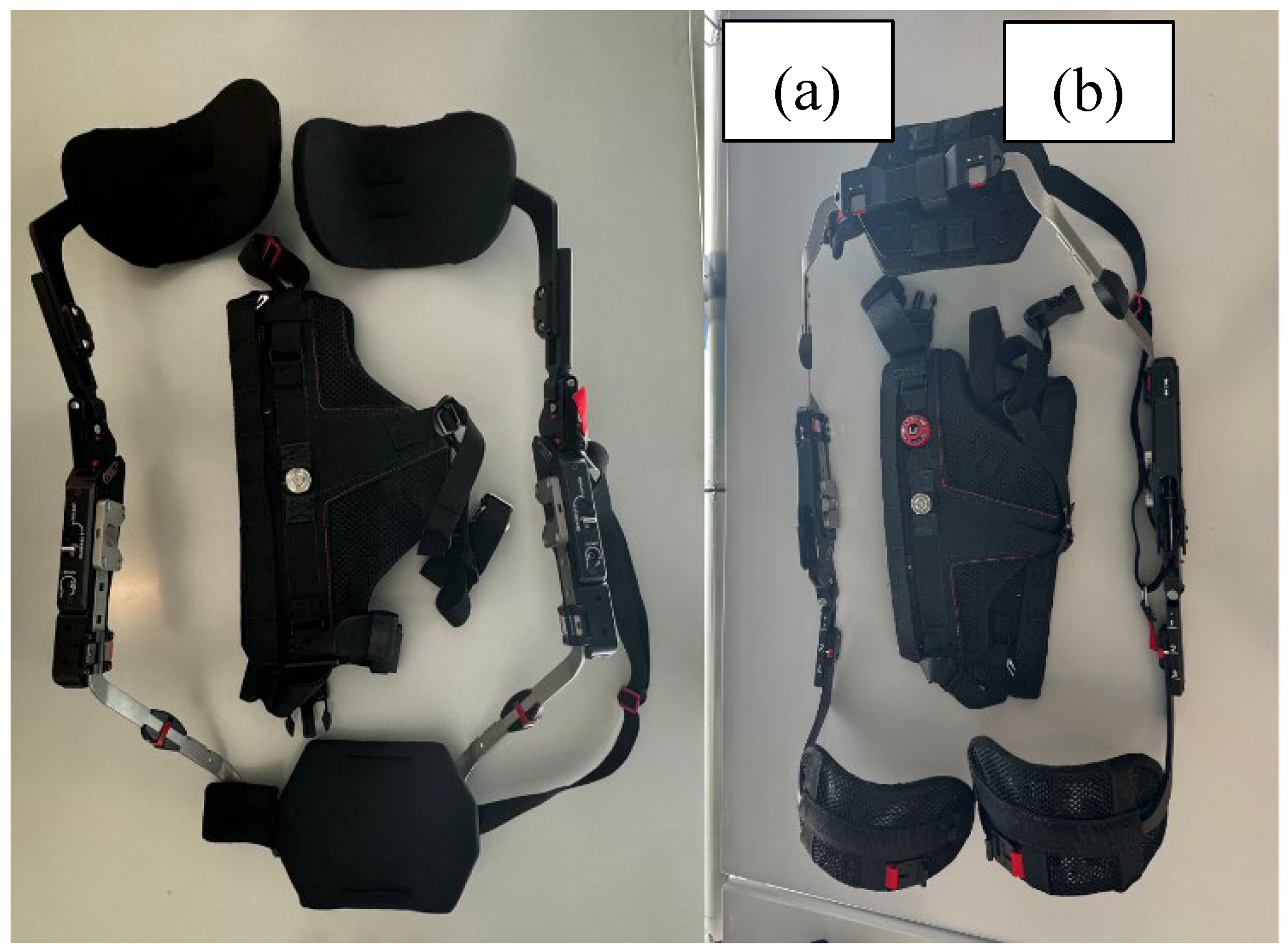
Figure 2.
Procedure setup and task performance in the lab; (a) front and back view of the BExo; (b) tasks completed by participants.
Figure 2.
Procedure setup and task performance in the lab; (a) front and back view of the BExo; (b) tasks completed by participants.
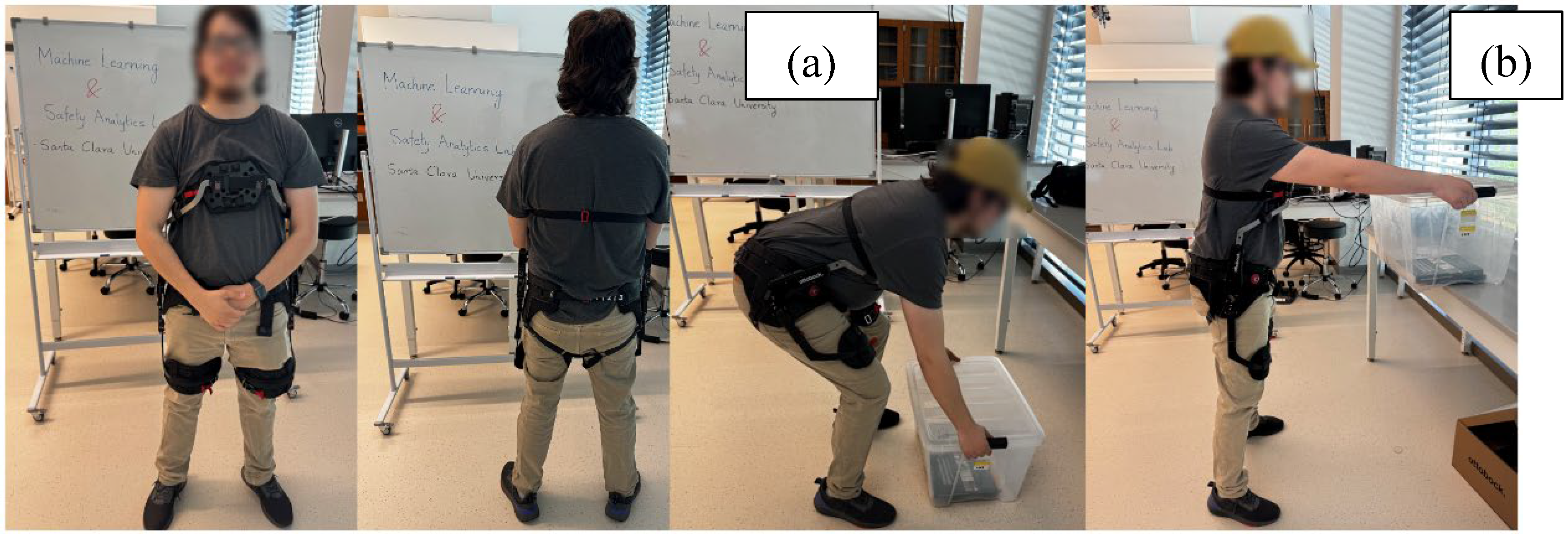
Figure 3.
Average PPE per support type.
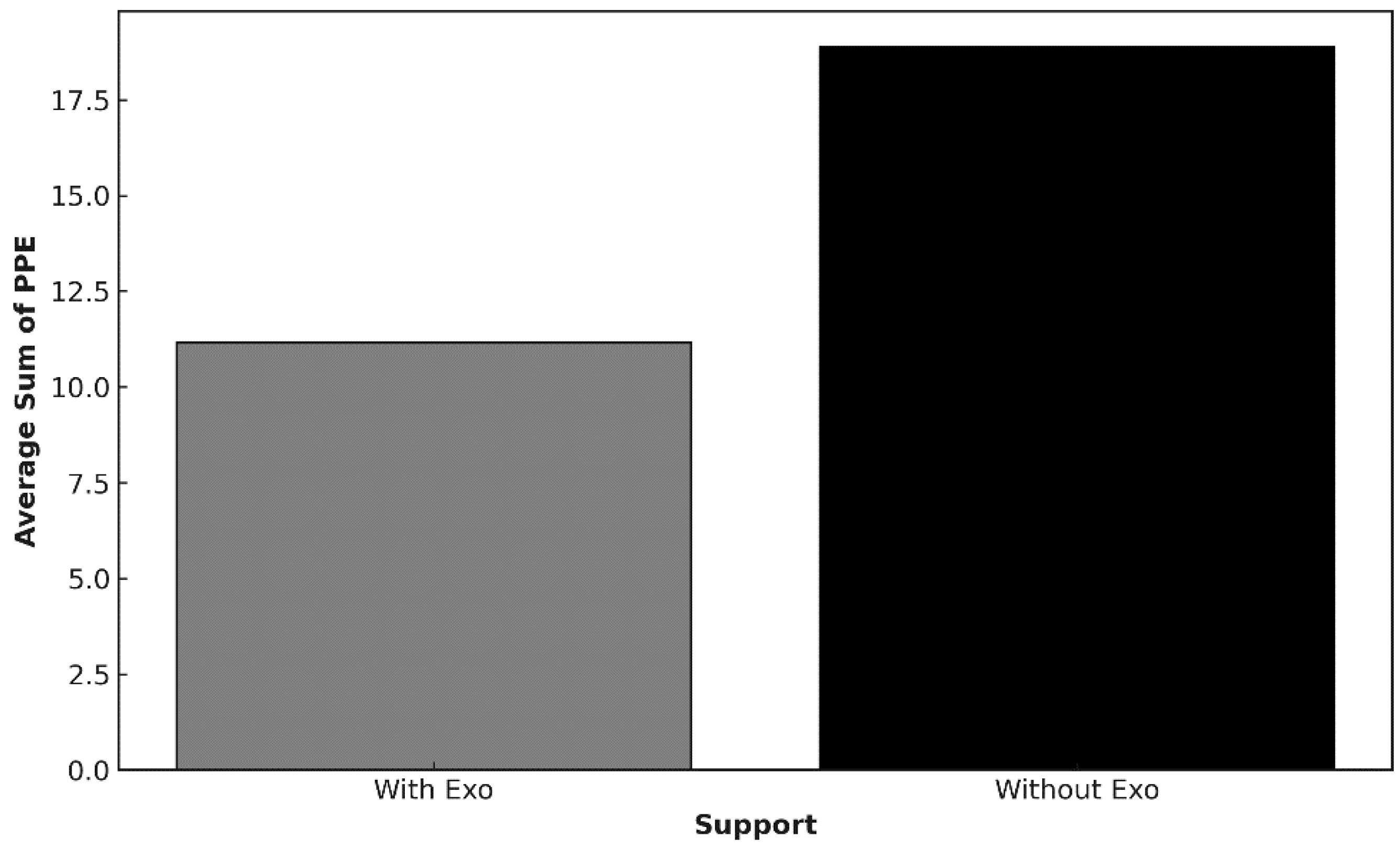
Figure 4.
Average sum of PPE with and without BExo per body part.
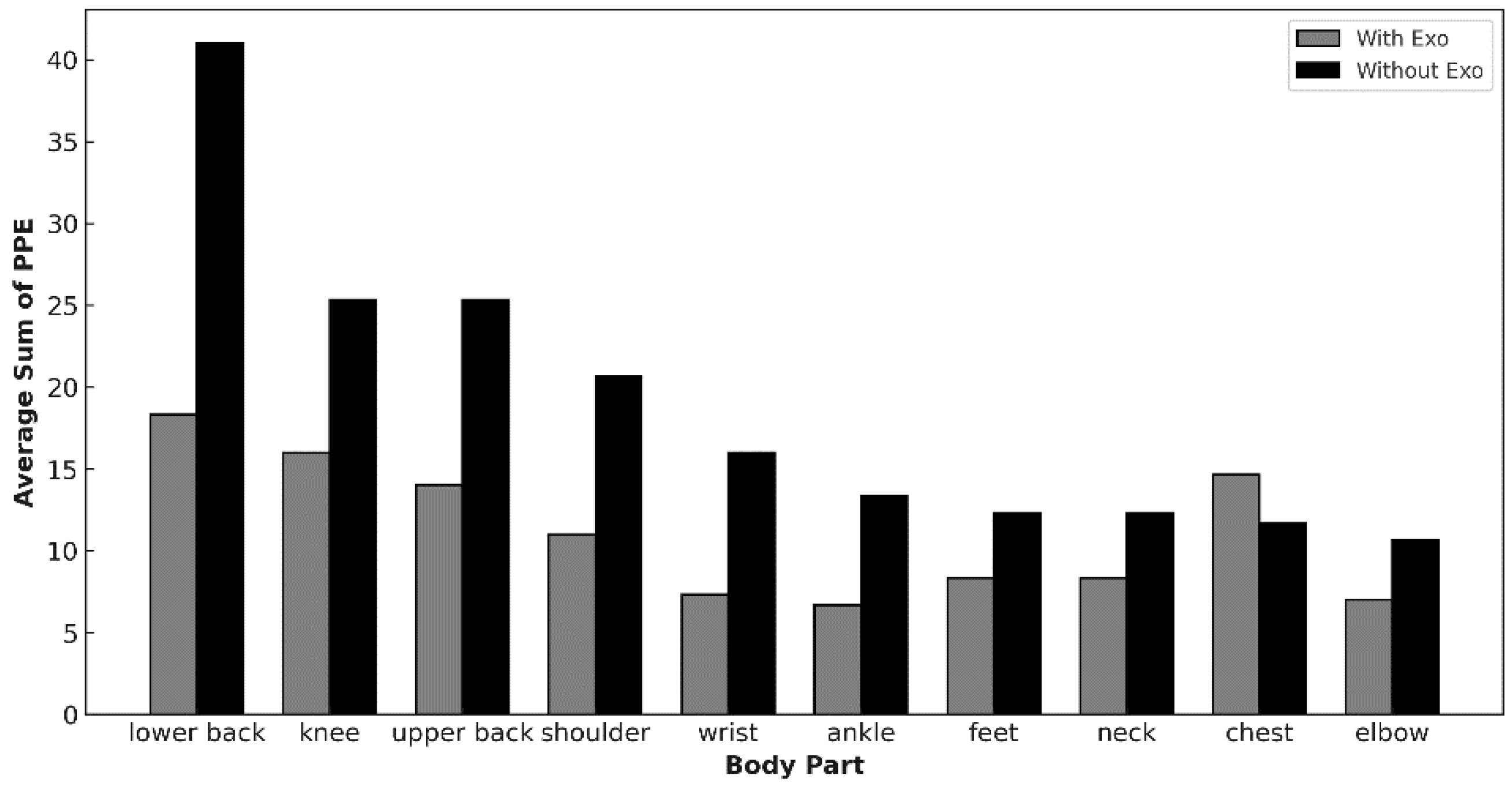
Figure 5.
Effect of BExo support on PPE for different tasks.
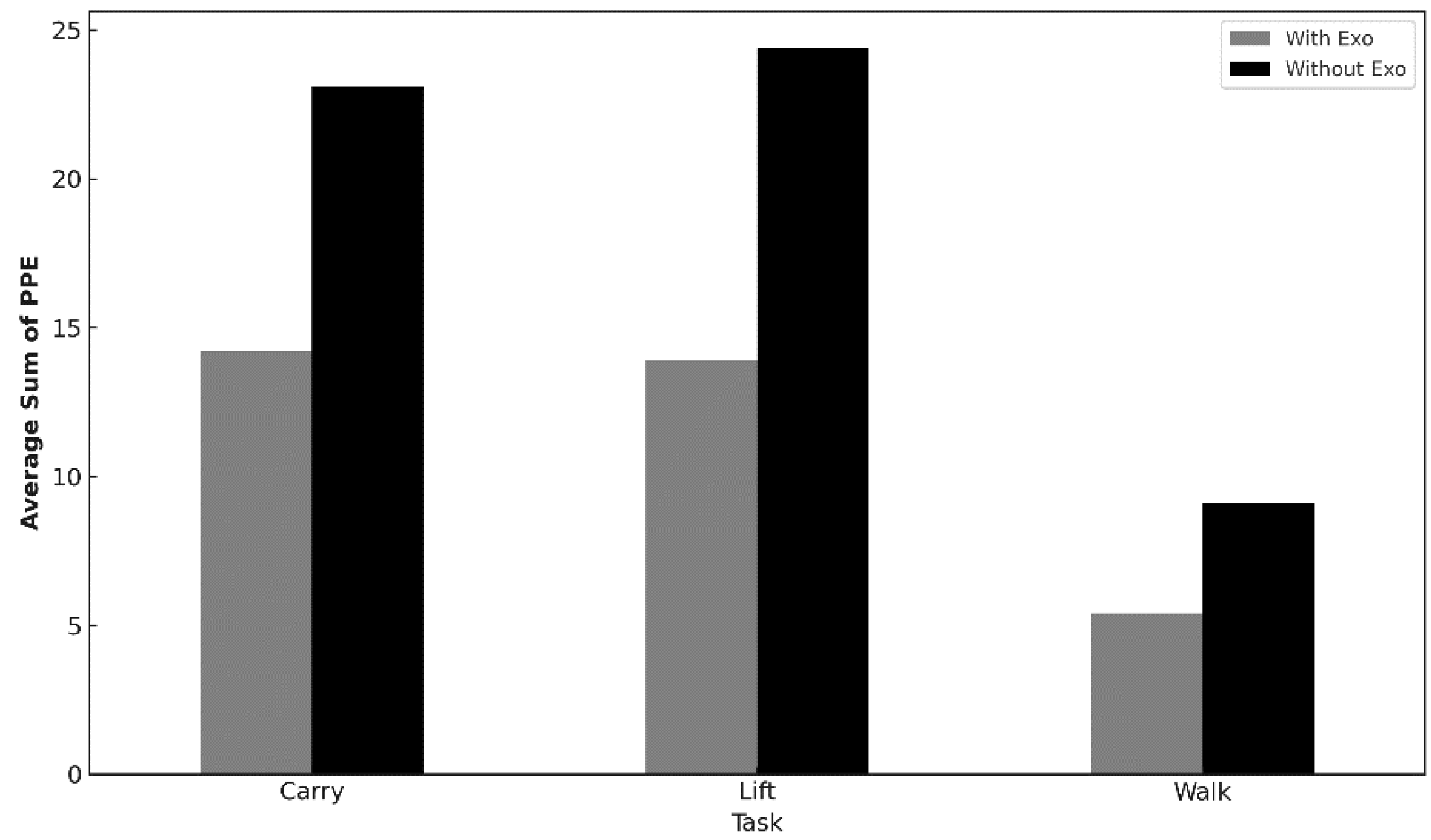
Figure 6.
Average sum of PPE per body part for lifting a box.
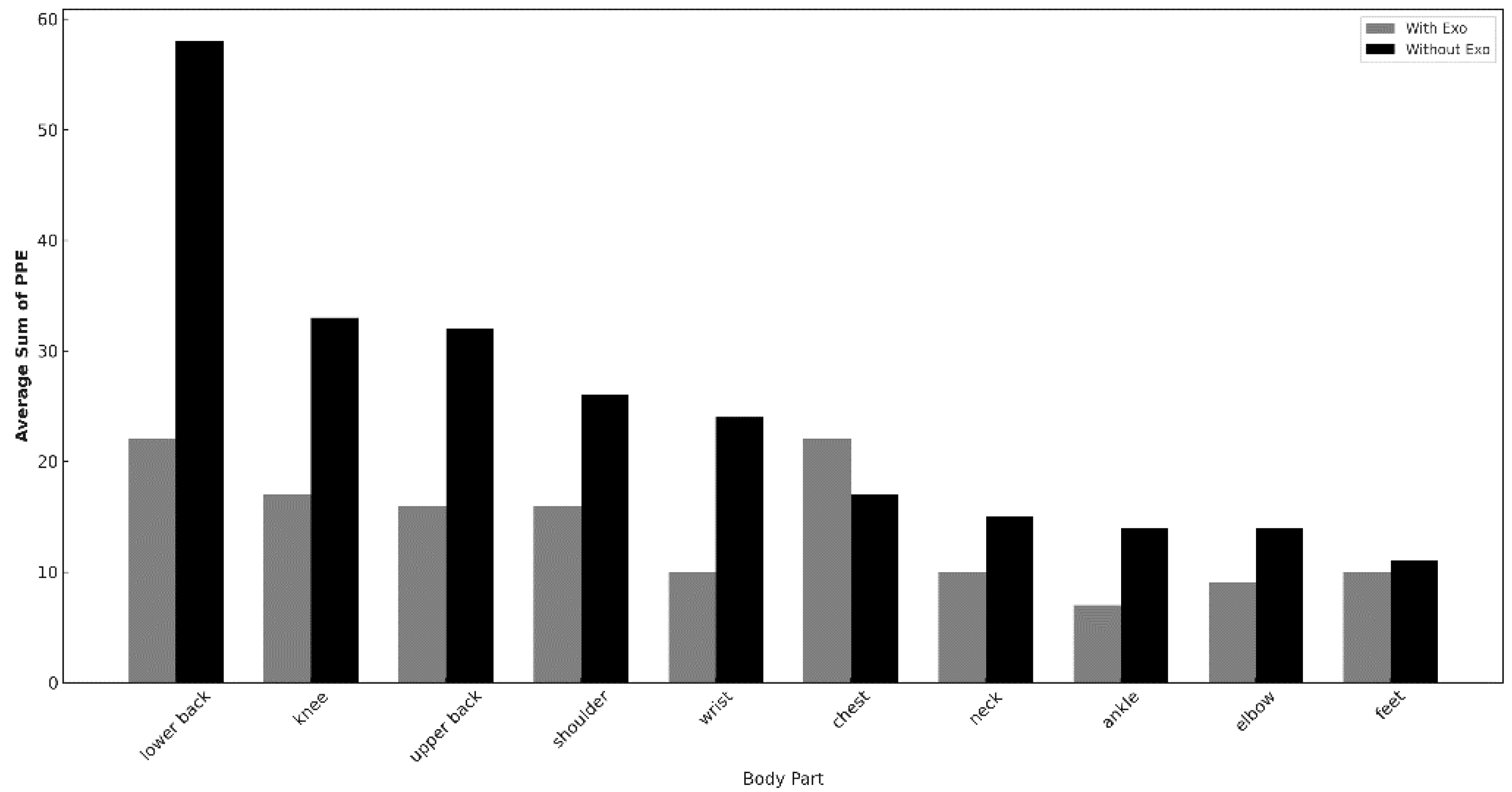
Figure 7.
PPE per body part based on support for carrying a box.
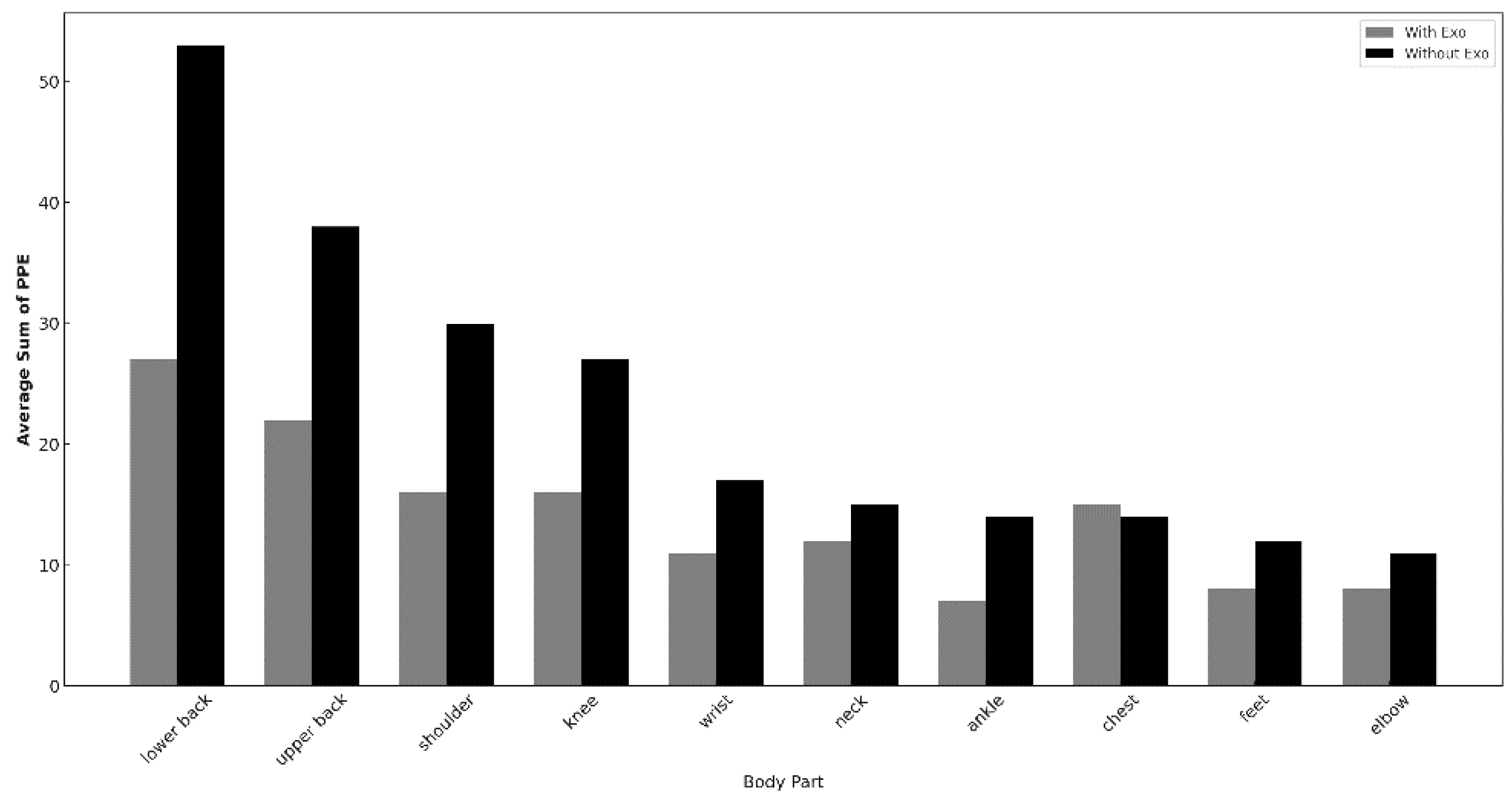
Figure 8.
Average sum of PPE per body part when walking with and without exo.
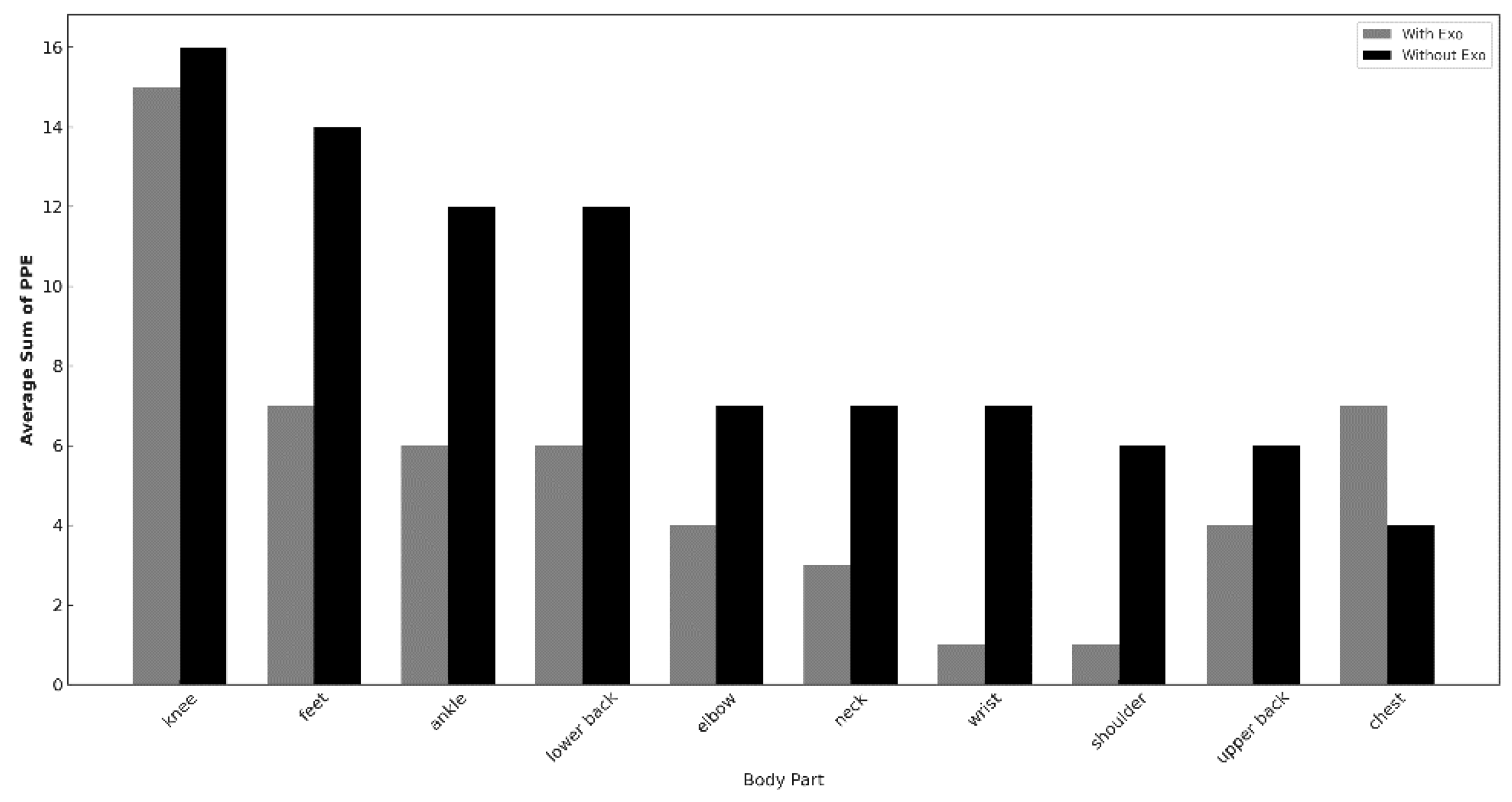
Figure 9.
Comparing descriptive statistics on BExo evaluation.
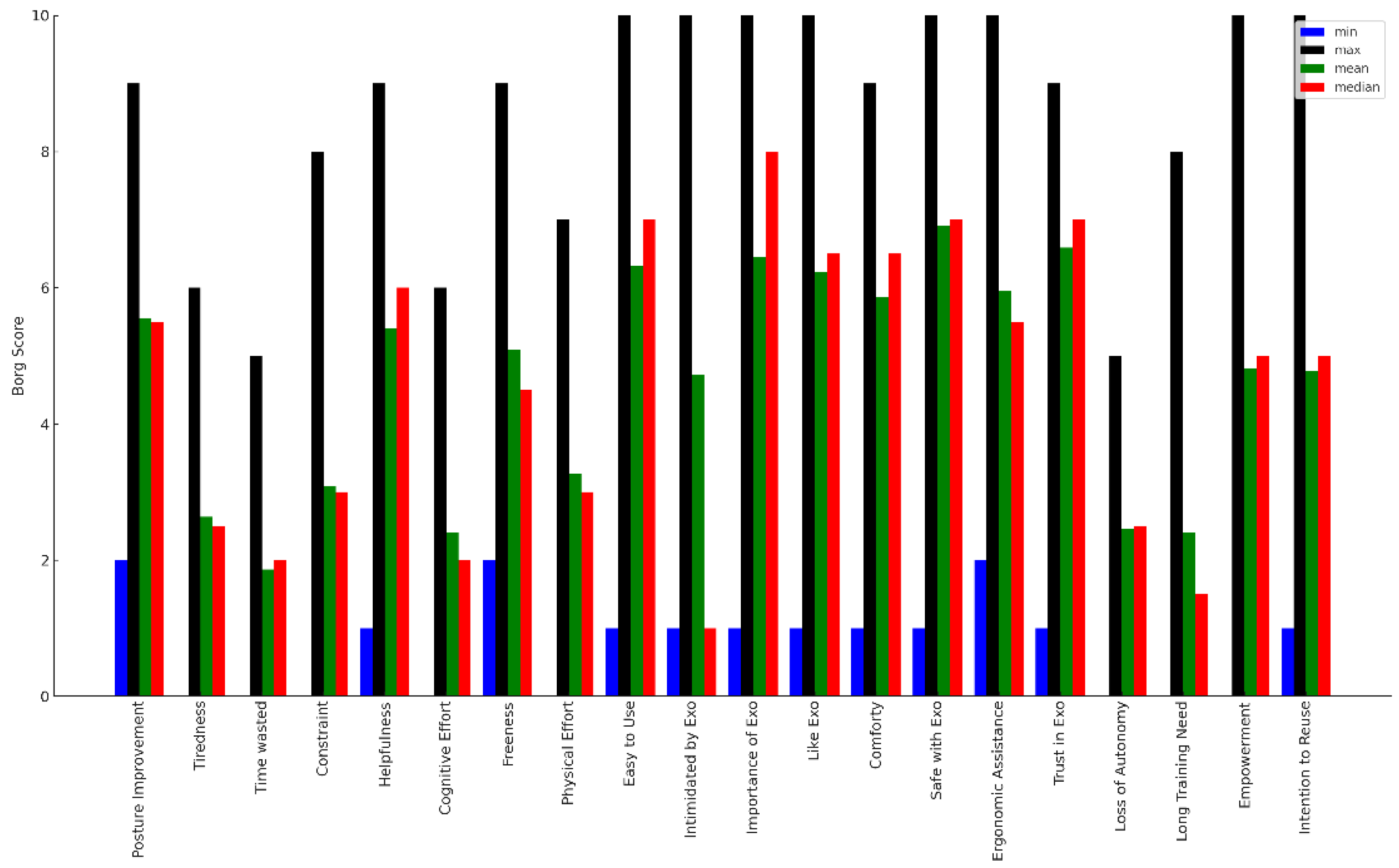
Figure 10.
Average score per attribute from 0-10 Borg scale questionnaire.
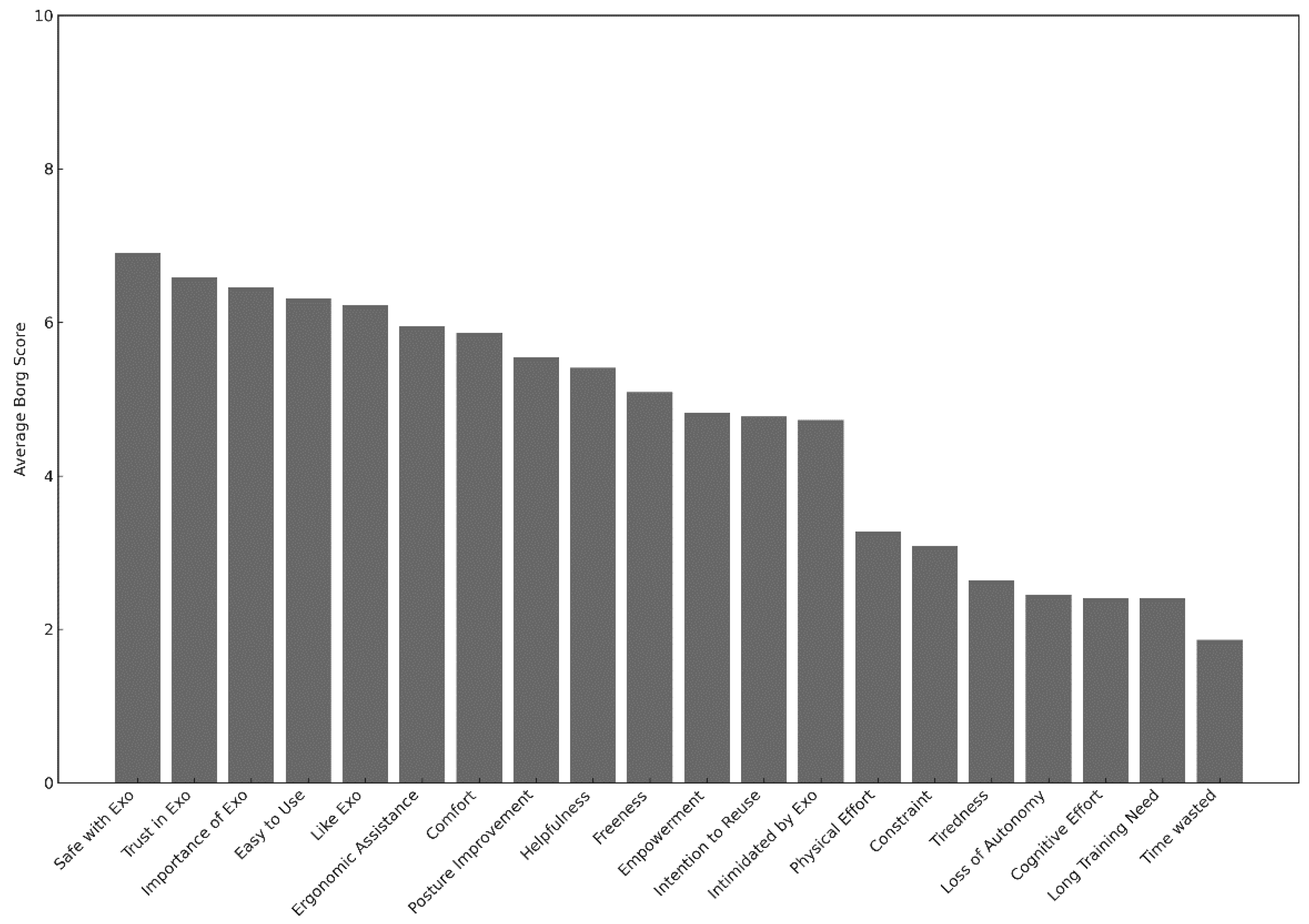
Table 1.
Task Specifications in the Study.
| Task | Repetitions | Duration | Specifications |
|---|---|---|---|
| Walking | 2 trials (one with; one without exo) | 2 minutes | Walk in the lab |
| Carrying a Box | 2 trials; 2 sets of 3 (one with; one without exo) | Distance of 2.6 m (8 ft) | Box weight: 7 kg (15.6 lbs.) |
| Lifting a Box | 2 trails; 2 sets of 3 (one with; one without exo) | At comfort pace | Box height placement: 90 cm (2 ft) |
Table 2.
ANOVA of PPE by Support.
| Source | DF | Sum of Square | Mean Square | F Ratio* |
|---|---|---|---|---|
| Support | 1 | 889.3500 | 889.350 | 8.0678 |
| Error | 58 | 6393.6333 | 110.235 | |
| C. Total | 59 | 7282.9833 |
*Corresponding P-value is 0.0062 at α=0.05 level.
Table 3.
ANOVA of PPE by Task.
| Source | DF | Sum of Square | Mean Square | F Ratio* |
|---|---|---|---|---|
| Task | 2 | 1812.1333 | 906.067 | 9.4402 |
| Error | 57 | 5470.8500 | 95.980 | |
| C. Total | 59 | 7282.9833 |
*Corresponding P-value is 0.0003 at α=0.05 level.
Table 4.
Two-Way ANOVA for Effect of Task, Support, Body Part on PPE.
| Source | DF | Sum of Square | F Ratio | P-Value |
|---|---|---|---|---|
| Task | 2 | 1812.1333 | 56.64 | <0.0001* |
| Support | 1 | 889.35000 | 55.59 | <0.0001* |
| Body part | 9 | 2344.4833 | 16.28 | <0.0001* |
| Task*Support | 2 | 126.4000 | 3.95 | <0.0378* |
| Task*Body part | 18 | 1216.866 | 4.22 | <0.0046* |
| Support*Body part | 9 | 605.816 | 4.21 | <0.0019* |
*Corresponding P-value is less than α=0.05 level showing statistical significance.
Table 5.
Results from Tow-Way ANOVA model (all statistically significant).
| Term | Estimate | Std Error | t-ratio | P-value |
|---|---|---|---|---|
| Intercept | 15.0167 | 0.5163 | 29.0800 | <.0001 |
| Task[C] | 3.6333 | 0.7302 | 4.9800 | <.0001 |
| Task[L] | 4.1333 | 0.7302 | 5.6600 | <.0001 |
| Support[Ex] | -3.8500 | 0.5163 | -7.4600 | <.0001 |
| BodyPart[ankle] | -5.0167 | 1.5490 | -3.2400 | 0.0046 |
| BodyPart[elbow] | -6.1833 | 1.5490 | -3.9900 | 0.0009 |
| BodyPart[feet] | -4.6833 | 1.5490 | -3.0200 | 0.0073 |
| BodyPart[knee] | 5.6500 | 1.5490 | 3.6500 | 0.0018 |
| BodyPart[lower back] | 14.6500 | 1.5490 | 9.4600 | <.0001 |
| BodyPart[neck] | -4.6833 | 1.5490 | -3.0200 | 0.0073 |
| BodyPart[upper back] | 4.6500 | 1.5490 | 3.0000 | 0.0077 |
| Support[Ex]*BodyPart[chest] | 5.3500 | 1.5490 | 3.4500 | 0.0028 |
| Support[Ex]*BodyPart[lower back] | -7.4833 | 1.5490 | -4.8300 | 0.0001 |
| Task[C]*BodyPart[lower back] | 6.7000 | 2.1906 | 3.0600 | 0.0068 |
| Task[C]*BodyPart[upper back] | 6.7000 | 2.1906 | 3.0600 | 0.0068 |
| Task[L]*BodyPart[lower back] | 6.2000 | 2.1906 | 2.8300 | 0.0111 |
Disclaimer/Publisher’s Note: The statements, opinions and data contained in all publications are solely those of the individual author(s) and contributor(s) and not of MDPI and/or the editor(s). MDPI and/or the editor(s) disclaim responsibility for any injury to people or property resulting from any ideas, methods, instructions or products referred to in the content. |
© 2024 by the authors. Licensee MDPI, Basel, Switzerland. This article is an open access article distributed under the terms and conditions of the Creative Commons Attribution (CC BY) license (https://creativecommons.org/licenses/by/4.0/).
Copyright: This open access article is published under a Creative Commons CC BY 4.0 license, which permit the free download, distribution, and reuse, provided that the author and preprint are cited in any reuse.
Alerts
MDPI Initiatives
Important Links
© 2024 MDPI (Basel, Switzerland) unless otherwise stated








